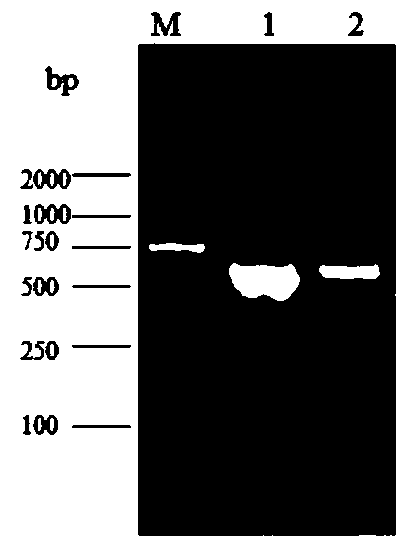A kind of pseudorabies virus llt region δintron strain and its construction method and application
A technology of pseudorabies virus and pseudorabies, which is applied in the direction of antiviral agents, viruses/bacteriophages, and methods based on microorganisms, can solve problems such as mutation, the inability of the vaccine Batha-K61 to produce protection, and economic losses in the pig industry. Filter for quick results
- Summary
- Abstract
- Description
- Claims
- Application Information
AI Technical Summary
Problems solved by technology
Method used
Image
Examples
Embodiment 1
[0065] Experimental materials and reagents used in this study:
[0066] 18-T was purchased from Dalian Bao Biological Engineering Co., Ltd. (TaKaRa), product number D101A; pcDNA3.1(+) was purchased from Invitrogen Company, product number V79020.
[0067] GIBCO fetal bovine serum and neonatal bovine serum were purchased from Invitrogen, Cat. No. 10099-141.
[0068] DMEM medium was purchased from Invitrogen, USA. Item No.: 12800-017.
[0069] Opti-MEM (1×) medium was purchased from Invitrogen, USA. Item No.: 11058-021.
[0070] 0.25% Trypsin-EDTA (1×) was purchased from Invitrogen, USA. Item No.: 25200-072.
[0071] Phenol red-free DMEM medium was purchased from HyClone, USA. Item No.: SH3021115.
[0072] AxyPrep DNA Gel Recovery Kit was purchased from Ai Si Jin Biological Co., Ltd. Item No.: AP-GX-50.
[0073] Lipofectamine2000, a liposome transfection kit, was purchased from Invitrogen. Item No.: 11668-500.
[0074] Restriction enzymes were purchased from Dalian B...
Embodiment 2
[0085] PCR amplification of the upstream and downstream homology arms of Intron:
[0086] According to the full-length nucleotide sequence of the PRV genome (Genbank accession number is BK001744.1) published on GenBank (http: / / www.ncbi.nlm.nih.gov / ), design 2 pairs of primers (the sequence of the primer pair is shown in the table 1. All primers were synthesized by Shanghai Sangon Biotechnology Co., Ltd.), using the plasmid in the PRV genome library as a template to amplify the upstream and downstream homology arms of Intron respectively. For the detailed sequence of the upstream and downstream homology arms, see SEQ ID NO: 1 and SEQ ID NO: 3 in the sequence listing, and for the detailed sequence after Intron deletion, see SEQ ID NO: 2 in the sequence listing.
[0087] Table 1 Primers used for amplification of the upstream and downstream homology arms of Intron gene and identification of recombinant virus
[0088]
[0089] Table Note: The underlined part of the primer seque...
Embodiment 3
[0096] Construction of the transfection vector:
[0097] The upstream and downstream homology arms of Intron were amplified by PCR, recovered with AxyPrep DNA Gel Extraction Kit (purchased from Axygen), and ligated into pMD18-T vector respectively, named pZF11-81 and pZF11-82 respectively. Use HindIII and EcoRI to double digest the plasmid pZF11-81 and pcDNA3.1(+) vector, recover the upstream homology arm fragment and the vector, connect the upstream homology arm into the digested pcDNA3.1(+), and name the plasmid is pZF11-83. pZF11-82 was double-digested with EcoR I and XhoI, and the downstream homology arms were recovered and inserted into pZF11-83 after digestion with the same restriction enzymes, and the plasmid pZF11-84 containing the upstream and downstream homology arms of Intron was constructed (see figure 1 -A), identified by various restriction endonucleases to construct correctly ( figure 2 -A). In order to facilitate the screening of recombinant viruses, an EGF...
PUM
 Login to View More
Login to View More Abstract
Description
Claims
Application Information
 Login to View More
Login to View More - R&D
- Intellectual Property
- Life Sciences
- Materials
- Tech Scout
- Unparalleled Data Quality
- Higher Quality Content
- 60% Fewer Hallucinations
Browse by: Latest US Patents, China's latest patents, Technical Efficacy Thesaurus, Application Domain, Technology Topic, Popular Technical Reports.
© 2025 PatSnap. All rights reserved.Legal|Privacy policy|Modern Slavery Act Transparency Statement|Sitemap|About US| Contact US: help@patsnap.com



